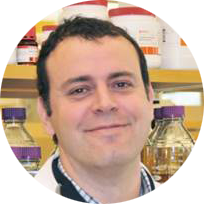Gene Therapy Strategies for Tay-Sachs Disease

What is Tay-Sachs disease?
Tay-Sachs disease is a devastating neurological disorder characterized by deterioration of mental and physical abilities starting at 6 months of age, usually resulting in death by the age of 5. It is one of 40 rare, inherited metabolic disorders called lysosomal storage diseases, that result from a breakdown in a cell’s ability to remove or recycle waste products (i.e. toxins) due to the missing enzyme Hexosaminidase A (HexA). The gradual build up of waste inside the cell results in cell death and causes the slow breakdown of motor and neurological function in patients.
Tay-Sachs is most common in Eastern European people of Jewish descent, also known as Ashkenazi Jews. People of Cajun, French-Canadian and Irish descent are also at higher risk for this devastating disease. It’s estimated that the occurrence of the recessive gene responsible for Tay-Sachs in the Ashkenazi community is 1 in 27 compared to 1 in 50 in people of Irish descent and 1 in 250 in the rest of the population. Patients with the disease must inherit the recessive form of the gene from both parents. Though genetic screening has greatly reduced deaths from Tay-Sachs, approximately 25 to 30 individuals die from the disease annually.
Dr. Miguel Sena-Esteves, PhD
A leading researcher for Tay-Sachs disease
Miguel Sena-Esteves, PhD, is an associate professor of neurology and a member of the Horae Gene Therapy Center. Miguel Sena-Esteves received his PhD in biomedical sciences from the University of Porto, Portugal, where he started his work in gene therapy. His laboratory at UMass Chan focuses on the development of adeno-associated virus (AAV) based gene therapies and capsid engineering for Tay-Sachs disease, GM1-gangliosidosis, Huntington’s disease, ALS, and brain tumors.
Dr. Sena-Esteves leads the Tay-Sachs Gene Therapy Consortium with the focus to develop an AAV gene therapy and conduct the first-in-human clinical trial. He is also leading the pre-clinical development efforts for a GM1-gangliosidosis AAV gene therapy in collaboration with Lysogene. In 2011 he received the Outstanding New Investigator Award from the American Society of Gene & Cell Therapy (ASGCT) for his many contributions to the field of gene and cell therapy. He has authored 88+ peer-reviewed publications and is inventor on several patent applications.
Dr. Sena-Esteves's gene therapy strategy on Tay-Sachs disease
Dr. Sena-Esteves and his lab members have introduced a new paradigm for brain tumor gene therapy based on the genetic modification of normal brain to create an environment, which is non-permissive to tumor growth. They have consistently demonstrated the effectiveness of this approach for preventing the formation and precluding growth of brain tumors using xenograft models in nude mice.
Currently, the Sena-Esteves Lab is working on devising new ways to deliver therapeutic levels of the missing enzyme Hexosaminidase A (HexA) to the entire brain by injection of adeno-associated virus (AAV) vectors into specific structures in the central nervous system. Another research area of the lab is to work on developing new AAV vectors capable of crossing the blood brain barrier for effective gene delivery to the brain after intravascular infusion.
Breakthrough Results
Dr. Sena-Esteves has devised new ways to deliver therapeutic levels of the missing enzymes to the entire brain by injection of adeno-associated virus (AAV) vectors into specific structures in the Central Nervous System (CNS). Based on the exceptional results that he and his lab members have obtained in animal models and pre-clinical studies they hope to soon move on to a human clinical trial for Tay-Sachs disease.
The proposed trial will employ a recombinant adeno-associated virus vector (rAAV) to replace the faulty gene that produces the enzyme responsible for removing and recycling waste products in cells. Once introduced into brain, the functioning gene begins making the missing enzyme, turning parts of the brain into mini-factories. Capitalizing on the natural pathways of the brain, those enzymes are then distributed throughout the brain, allowing cells to resume their natural metabolic functions and remove waste products. Similar work is planned for GM1-gangliosidosis.
Dr. Sena-Esteves is now looking for funding
to take his pre-clinical advances to clinical trials in humans
|
Miguel Seva-Esteves, PhDAssistant Professor, Department of Neurology and Horae Gene Therapy Center |

